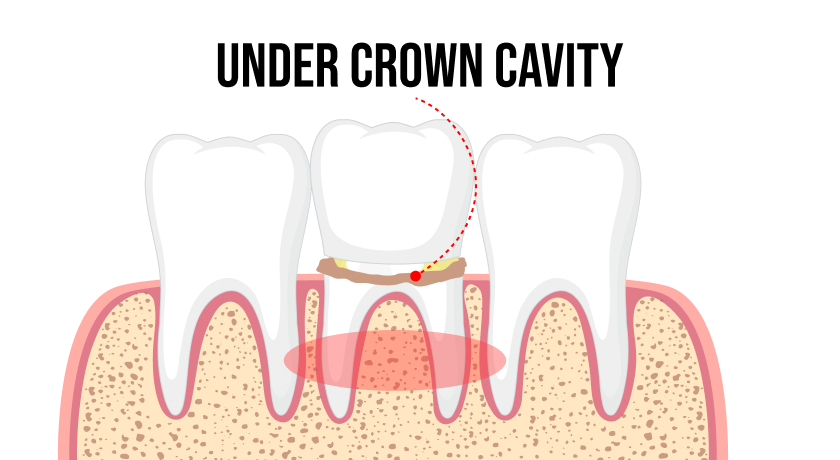If you’ve ever wondered, “Can you get a cavity under the crown?” you’re not alone. Many of our patients are surprised to learn that yes, tooth decay can indeed develop underneath a dental crown. It might seem counterintuitive—after all, doesn’t a crown protect your tooth?
While crowns are incredibly effective dental restorations, the underlying tooth structure remains vulnerable to decay under certain circumstances. Understanding how this happens and what you can do about it empowers you to maintain optimal oral health and protect your investment in dental work.
Let’s explore everything you need to know about cavities under crowns and how to prevent them.

How Cavities Can Form Under Your Crown
When you receive a crown placement, your dental professional carefully prepares your natural tooth by removing damaged portions while preserving healthy tooth structure. The crown then acts like a protective cap, covering the visible portion of your tooth. However, the natural tooth remains underneath, and this is where problems can begin.
The most vulnerable area is typically at the gum line and the base of the crown, where the crown meets your natural teeth. If the seal between the crown and your tooth becomes compromised over time, food particles and bacteria can infiltrate this space. When bacteria interact with sugars and starches from your diet, they produce acids that attack your tooth enamel, leading to tooth decay.
Your crowned tooth faces the same challenges as your natural teeth when it comes to bacterial exposure. Poor oral hygiene, combined with time and wear, can create the perfect environment for a cavity forms beneath even the most well-crafted dental restoration. This is why proper care and regular dental checkups remain crucial even after receiving a new crown.
Common Causes and Risk Factors
Several factors can increase your risk of decay under an existing dental crown:
- Poor oral hygiene practices that allow plaque buildup along the gum line and around the crown margins
- Regular consumption of acidic foods and sugary beverages that feed harmful bacteria in your mouth
- An old crown that has begun to lose its tight seal over time, creating entry points for bacteria
- Inadequate crown fit from the initial crown procedure, leaving microscopic gaps where bacteria can accumulate
- Underlying health conditions like diabetes or dry mouth that affect your overall oral health and increase decay risk
The intersection of these risk factors creates an environment where recurrent decay can develop, even around a previously restored tooth. Understanding these causes helps you take proactive steps to protect your dental investment.

Recognizing the Early Signs and Symptoms
Early detection of decay under your crown is crucial for preserving your underlying tooth and avoiding more extensive dental treatment. Pay attention to these warning signs that may indicate developing problems with your crowned tooth.
Tooth sensitivity, particularly to hot, cold, or sweet substances, often signals that something has changed beneath your crown. If you notice new or increasing tooth pain around a previously comfortable crowned tooth, this could indicate that decay has reached deeper layers of your natural tooth structure.
Visual changes around the gum line, such as darkening, swelling, or visible decay at the base of the crown, are clear indicators that require immediate attention from your dentist. You might also notice a persistent bad taste or odor coming from the area, which can signal infected tissue or advanced decay.
Don’t ignore these early signs, thinking they’ll resolve on their own. The symptoms of tooth decay under a crown often worsen progressively, and early intervention typically means simpler, more conservative treatment options.
Available Treatment Options
When decay develops under your crown, several treatment options are available depending on the extent of the damage:
- Crown removal and cavity treatment for small cavities that haven’t compromised the tooth’s structural integrity, followed by a new crown placement
- Root canal therapy when decay has reached the tooth’s pulp, requiring removal of infected tissue before crown replacement
- Complete crown replacement with better fitting restoration to prevent future issues and restore proper function
- Dental implant consideration in severe cases where the underlying tooth cannot be saved due to extensive damage
Your dental team will thoroughly evaluate your specific situation through examination and imaging to determine which approach offers the best long-term outcome for your dental health. The root canal procedure, while more involved than simple cavity treatment, often allows you to keep your natural tooth structure when performed promptly.
Preventing Cavities Under Your Crown
Prevention remains your best defense against developing decay under your crown. Good oral hygiene forms the foundation of protecting both your natural teeth and any dental work you’ve received. This means regular brushing with fluoride toothpaste, daily flossing around your crown, and using an antimicrobial mouthwash to reduce harmful bacteria.
Regular visits to your dental office allow for professional dental cleaning and early detection of potential problems before they become serious issues. Your dental professional can spot early stages of decay that might not yet cause symptoms, making treatment simpler and less expensive.
Proper care also includes being mindful of your diet, particularly limiting acidic foods and sugary snacks that contribute to tooth decay. Consider how your eating habits affect your overall health and specifically your oral health. When you do consume these foods, try to rinse with water afterward and wait at least an hour before brushing to avoid damaging softened enamel.
When to Contact Our Dental Office
Don’t wait if you’re experiencing any concerning symptoms around your crowned tooth. Tooth pain, increased sensitivity, or visible changes around your crown require prompt attention to prevent further damage to your underlying tooth structure.
Schedule regular dental checkups every six months, or more frequently if recommended by your dental team. These regular visits allow us to monitor your crowns and overall oral health, catching potential issues in their early stages when treatment is most effective.
If you’re experiencing severe pain or signs of infection, contact our office immediately. We understand that dental issues don’t always occur during regular office hours, and we’re committed to helping you maintain your optimal oral health.
Your Path to Continued Dental Health
Understanding that cavities can develop under crowns shouldn’t cause anxiety—it should empower you to take proactive steps in protecting your oral health. With proper care, regular checkups, and prompt attention to any concerning symptoms, your crowned teeth can serve you well for many years.
Remember that investing in preventive care is always more comfortable and cost-effective than addressing advanced dental problems. If you have concerns about any of your dental work or want to book an appointment for a routine checkup, we’re here to support your journey toward optimal oral health.
Contact our dental office today to schedule your visit and keep your smile healthy for years to come.



